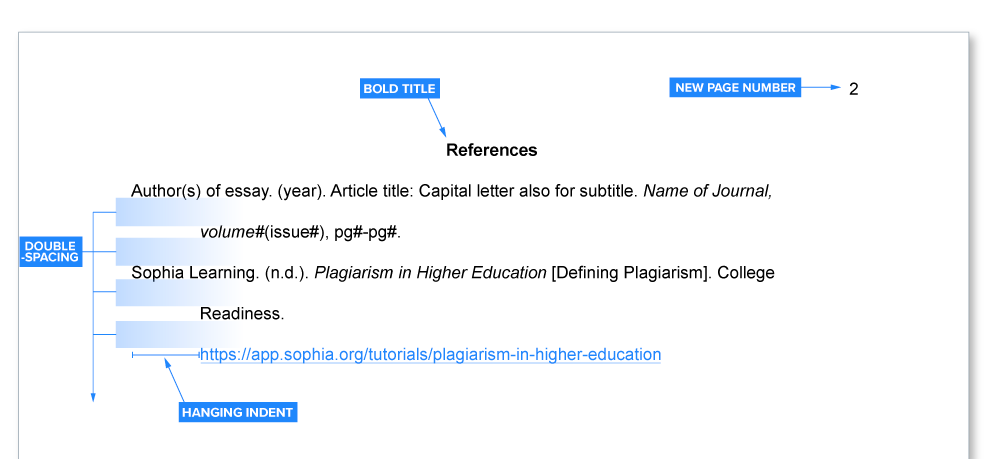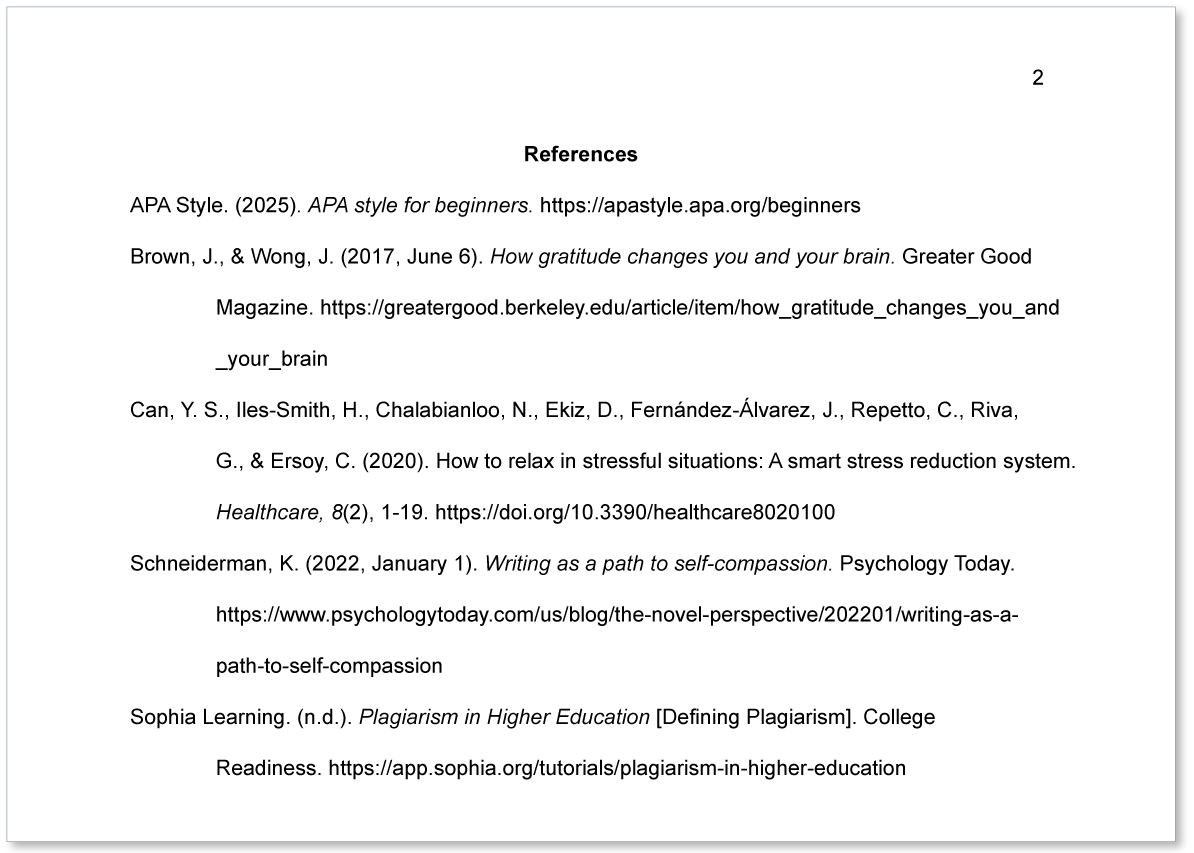Table of Contents |
There are different style guides for different fields and organizations, and APA is what we use at Sophia. APA stands for American Psychological Association and is a set of guidelines for formatting documents and citing source information. APA style is standardized. Following this style will make your work look professional, keep your ideas organized, and give credit to the original authors of any sources you use in your work, allowing you to produce ethical and honest writing. If you want to learn more in general about APA style, explore the APA website.
If your Touchstone does not include a submission template, you may need to create a document that follows the APA style. Here is an APA template you can download:
If you want to set up your document in APA format independently, follow these guidelines:
Besides the obvious benefit of meeting the rubric requirements and becoming competent in the skill, there is a broader benefit of exploring source information and integrating the research into your writing.
First, using credible source information and citing the source information allows you to produce honest work. Academic integrity is important in every step of writing your papers. Academic environments, such as Sophia Learning courses and college classes, as well as the workplace, expect honest work, and giving credit to the sources is the first step. Your readers can trust you because you presented the ideas in an ethical, honest way. APA does require sources to be cited, but it is more than that: Being trustworthy, ethical, and honest are characteristics that are valued in life.
Second, in addition to upholding academic integrity, citing the source information and using credible sources helps strengthen your writing and add support to your ideas. The experts took their knowledge and time to publish their ideas, and you can use their published expertise to strengthen the argument or develop the claim more fully. Using the best, credible, and reliable sources is a reflection of you as a writer.
A third benefit of citing the source information is that your readers can continue the research if they want. Your readers can find the same sources that you used and learn more about the topic, verify your claims, and explore the research more fully. Always make sure to use sources that others can locate and read if they want to. This helps you establish a thoughtful and honest reputation and invites further discussion to continue the research or build upon the current research.
When using source information in your paragraphs, think about the controlling voice. Your voice matters in your writing, so try to integrate the source information in a way that is smooth and flows. Use the source information to support your ideas. Consider the topic sentence and the supporting details included in a body paragraph. Ask yourself: What source information could be used here to support the topic sentence and help strengthen the paragraph? Then try to weave the source information into your writing so that the research supports your ideas (instead of replacing your ideas).
Next, let's look at how to cite source information properly.
In this section, we'll look at some options for in-text citations and examples for different types of sources. This is not a comprehensive list, but it will get you started.
An in-text citation is a brief reference within the text of your essay or assignment that indicates the source of information or ideas you have used. It requires less bibliographic information than a reference page entry. According to APA guidelines, in-text citations must include the following bibliographic data:
EXAMPLE
(Last name, year, p. #) or (Last name, year, para. #)The original source material includes the ideas or words you are using from an outside source, either through direct quotation, summary, or paraphrase. A narrative citation, also known as a signal phrase, is how you introduce the quote, paraphrase, or summary. It helps your writing flow by giving some context for the reader. There are many different ways to signal to your reader that you are shifting from your words and ideas to a source, as you'll see in the examples below. Parenthetical citations include any remaining bibliographic information that was not included in the signal.
Below are some examples to guide you. For each example, look at how you could weave the source into a piece of writing, either by paraphrasing or by direct quotation, using narrative citation or parenthetical citation. Then, click on the link to view the source in full.
Paraphrased source information:
Narrative citation: Schneiderman (2022) explained that journaling can help understand past traumas and gain insight into how writing can help heal.
Parenthetical citation: Journaling can help understand past traumas and gain insight into how writing can help heal (Schneiderman, 2022).
Direct quote source information:
Narrative citation: Schneiderman (2022) explained that “many reported an increased sense of self-respect and appreciation for the grace with which they faced challenges” (para. 8).
Parenthetical citation: When writing in a journal using third person, “many reported an increased sense of self-respect and appreciation for the grace with which they faced challenges” (Schneiderman, 2022, para. 8).
Notice with the direct quote how the paragraph number is provided in parentheses at the end of the sentence to indicate where the quotation comes from. The paragraph number is used when the page number cannot be found.
Source: Writing as a Path to Self-Compassion
Paraphrased source information:
Narrative citation: Brown and Wong (2017) explained that patience is important to seeing the benefits of gratitude.
Parenthetical citation: Patience and time are key factors in experiencing the benefits of gratitude (Brown & Wong, 2017).
Direct quote source information:
Narrative citation: Brown and Wong (2017) explained that “practicing gratitude may help train the brain to be more sensitive to the experience of gratitude down the line” (para. 21).
Parenthetical citation: The positive effects of “practicing gratitude may help train the brain to be more sensitive to the experience of gratitude down the line (Brown & Wong, 2017, para. 21).
Notice how two authors are cited: The ampersand (&) is used in the parenthetical citation, whereas narrative citations (or signal phrases) spell out the word "and" between the last names.
Source: How Gratitude Changes You and Your Brain
Paraphrased source information:
Narrative citation: Can et al. (2020) explained that practicing mindfulness offers many holistic benefits to the individual.
Parenthetical citation: Practicing mindfulness offers many holistic benefits to the individual (Can et al., 2020).
Direct quote source information:
Narrative citation: Can et al. (2020) explained that “mindfulness has been shown to be of benefit to physical and mental health” (p. 4).
Parenthetical citation: The positive effects of “mindfulness has been shown to be of benefit to physical and mental health” (Can et al., 2020, p. 4).
Notice the use of et al., which is a Latin abbreviation for "and others," and is used when a work has three or more authors. Only the first author’s name is used, and et al. is used for the other last names.
Source: How to Relax in Stressful Situations: A Smart Stress Reduction System
Paraphrased source information:
Narrative citation: The APA Style guide (2025) explained that APA style helps writers create clear and effective writing.
Parenthetical citation: Using the APA style can help writers create clear and effective writing (APA Style, 2025).
Direct quote source information:
Narrative citation: The APA Style guide (2025) explained that APA’s “purpose is to promote excellence in communication by helping writers create clear, precise, and inclusive sentences with a straightforward scholarly tone” (para. 5).
Parenthetical citation: APA is used to “promote excellence in communication by helping writers create clear, precise, and inclusive sentences with a straightforward scholarly tone” (APA Style, 2025, para. 5).
Source: APA Style for Beginners
Some Touchstone assignments may ask you to reference Sophia Learning tutorials. If you want or need to use a tutorial as a Touchstone source, it's easy to cite. Using APA formatting, the parenthetical reference for the in-text citation will include the corporate author and n.d., which stands for "no date," and is used when citing sources that do not have a specified date of publication.
EXAMPLE
(Sophia Learning, n.d.)Sometimes you may want to cite sources that are missing important information, like in the example above. If no date is included, use n.d. in place of the year. If no author is listed, look for a corporate author. If there is no corporate author, use the shortened title of the article in quotation marks.
EXAMPLE
(“Shortened Title,” year).In this section, we'll look at how to set up a reference page and some examples of reference citations for different types of sources.
APA formatting requires a reference page at the end of your document to list the sources you use in your work. The reference page provides more bibliographic information, which are the identifying details, for these sources. Each source that you mention in your assignment should be listed on the reference page so that your readers can easily find that information.
Take a look at how this sample reference page is set up:

To set up your reference page in APA format, follow these guidelines:
Let's look at a sample reference page for a research essay to understand how it should be constructed. This reference page lists all the sources we used as examples for in-text citations, organized in alphabetical order by author's last name. We will then look at each entry separately to understand what bibliographic information is included for different types of sources:

The first source is a website with a corporate author. Take a look at the citation with the elements you will need to include:
The second source is a website with two authors. Take a look at the citation with the elements you will need to include:
The third source is a scholarly journal article with multiple authors. Take a look at the citation with the elements you will need to include:
The fourth source is a website with one author. Take a look at the citation with the elements you will need to include:
The fifth source is a Sophia Learning tutorial. Take a look at the citation with the elements you will need to include:
Source: THIS TUTORIAL WAS AUTHORED BY SOPHIA LEARNING. PLEASE SEE OUR TERMS OF USE.
REFERENCES
APA Style. (2024). APA Style. Retrieved from www.apastyle.apa.org/